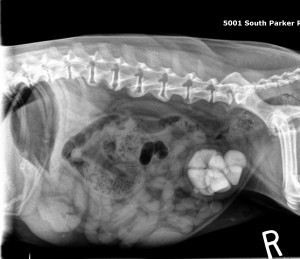When we met Nikki, the adorable rescue dachshund, she had dental disease, a cherry eye and bladder stones!
Meet Nikki! She is a gorgeous 8 year old dachshund who arrived at the Denver Dachshund Rescue and Transport (DDRT) which adopts out dog across Aurora and the metro area. Nikki came in with a number of medical concerns, including bladder stones, a cherry eye and a broken tooth. She was a rock star patient, and we wanted to have her help us teach you about some of these conditions.
- In the first installment, we will discuss bladder stones – you won’t believe the x-rays and rocks that came out of this poor girl! We want you to understand how bladder stones develop, how they are treated, and ways we try to prevent them.
- In the second installment we will talk about cherry eyes – what the heck are these, and how do we fix them?
- In the final installment, we will talk about a fractured tooth. Most dachshunds don’t have the best dental health due to their genetics and shape of their muzzle, but Nikki’s teeth were pretty good, except for this bad one – we want you to learn about what to look for!
Bladder stones (uroliths) in dogs and cats
Nikki had x-rays taken after some blood was seen in her urine, and look what we found! The first x-ray is a normal dog, and the arrow points to a normal bladder. It is filled with urine, and the actual wall of the bladder is very thin, only a few millimeters, much like a water balloon. The second x-ray is Nikki’s abdomen, showing her bladder chock full of rocks! Her bladder wall has thickened so much from the chronic irritation of the stones that we can actually see it clearly around the bladder stones. Minerals (such as those that make up bladder stones and bones) show up whiter on x-ray than the rest of the tissue, while gas and liquids (like her intestinal contents) show up darker.


Where do bladder stones come from?
Believe it or not, Nikki made them! Think of urine like orange juice. When the urine gets too acidic (pH too low) or too basic (pH too high), crystals of different minerals can form in the urine, kind of like orange juice pulp. If the urine is really dilute, like watered down juice, the crystals don’t have a chance to bump into each other very often. However, if the urine is very concentrated, like juice concentrate, the crystals come into contact frequently and begin to form ever-growing rocks.
How do we treat bladder stones?

Bladder stones typically have to be removed surgically, although in some cases they can be dissolved with a prescription diet. Surgery to remove these stones involves opening the abdomen, accessing the bladder, and cutting a hole into the bladder through which the stones are retrieved. In females, this is relatively straightforward, but in male dogs and cats (with longer and more narrow plumbing) this can be much more complicated, as stones can lodge into the narrow urethra and be difficult to remove. Think of the bladder like a giant water balloon – we find it incredible that you can cut a hole in the bladder, and then sew it up and get it to hold water again! The body is truly amazing!
Normally the bladder is a very thin walled balloon. However, Nikki’s stones had been present so long that not only did they grow to nearly an inch in diameter, but also they irritated the bladder wall so much it thickened with inflammation to nearly 1/2” thick! We believe, in Nikki’s case, that this was due to a chronic infection with the bacteria E. coli, which causes the urine pH to go high, causing a type of stone called a struvite (also known as ammonium phosphate) stone. However, we are still waiting for the final results from the lab analysis of this stone.
How do we prevent bladder stones?
In some cases, if we can catch a urinary tract infection early and treat completely, we can avoid recurrence of bladder stones. However, most dogs and cats that have formed stones in the past will form stones in the future, just like with humans who suffer from kidney stones. We have two main goals to try to prevent stone formation – we want to keep the urine as dilute as possible and we want to keep the urine pH as neutral as possible. We can achieve this through several methods, including canned prescription diets, careful choosing of treats/table scraps outside of these diets, and encouraging water consumption through fountains and other tricks that make drinking water more appealing to a pet. Most of the time, regular monitoring of the urine and bladder x-rays is needed to identify early causes for concern, in an attempt to avoid repeated surgery. Diets commonly prescribed for this condition include Royal Canin SO, Purina Veterinary Diets UR (St/Ox), and Science Diet C/D Multicare.
Could my dog or cat have bladder stones? How would I know?
Any pain in the bladder or associated with urination typically causes the pet to have small, frequent urinations (since urinations typically burn), and also to lick excessively at the genitalia. Sometimes pink, red or brown urine is also present, and much more visible on carpeting, sidewalks and snow than on grass or soil. Frequently, pets also begin to urinate in abnormal places when they have urinary tract pain – cats often urinate outside of their litter boxes and dogs often have accidents in the house. This is because infection and inflammation not only create a feeling of urgency, but also the animal often is unable to recognize that it is the URINE causing pain and not WHERE it is urinating, so continues to find new places and surfaces on which to void. If you are worried you are seeing any of these symptoms, it is smart to call your veterinarian for an exam, evaluation of their urine, and an x-ray if there is reason to believe stones may be present.
